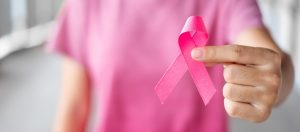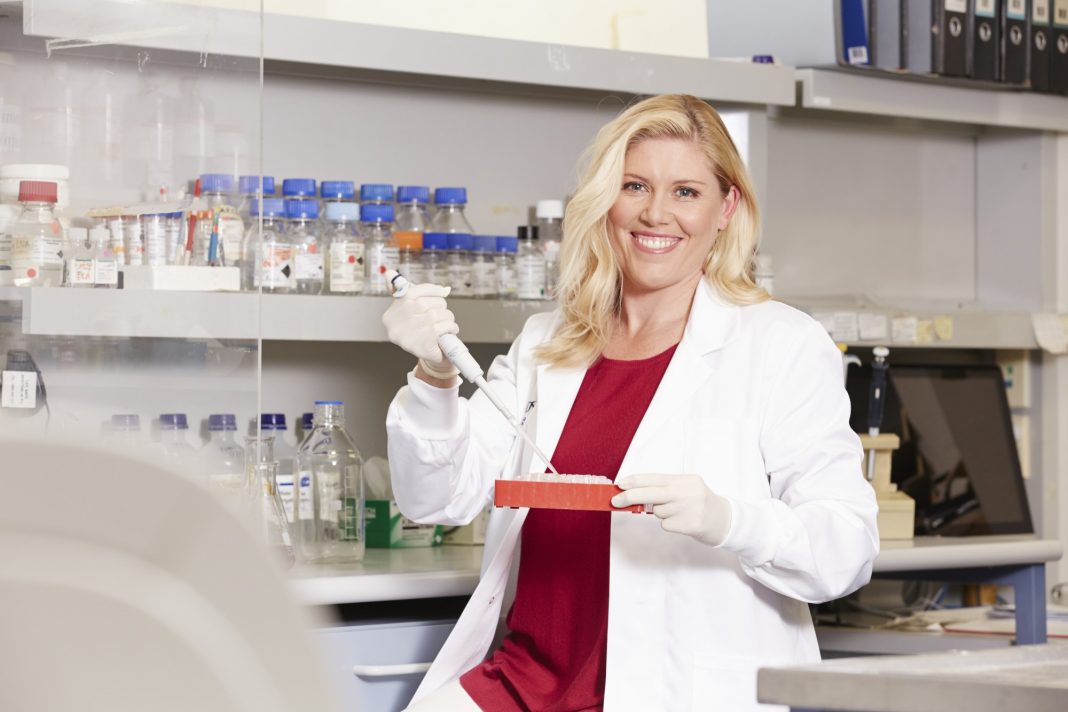In the October issue of Retail Pharmacy Assistants e-magazine, we shone the spotlight on the important work of the National Breast Cancer Foundation and spoke with Associate Professor Samantha Oakes, Director of Research Investment to learn more about the life-saving work of this organisation.
Tell us a little about your professional background and how you came to work at the National Breast Cancer Foundation (NBCF)? 
I’m a scientist and researcher focused on breast cancer research. I started my career in 2001 at the Garvan Institute of Medical Research, Sydney and received funding from the NBCF (I was a junior scientist) to begin my post-graduate studies, understanding the genetics of breast development and cancer. Ultimately, if we understand what goes wrong in breast cancer, we can work out ways of treating it better.
In my 20 years as a research scientist, I spent some time at the Walter and Eliza Hall Institute in Melbourne, also funded by a fellowship from the NBCF. There, I focused my efforts on understanding how specialised signals in breast cancer cells prevent them from dying, so that we can find better treatments that work in the most aggressive breast cancers. This year, I was employed at the NBCF as the new Director of Research Investment.
What does your role entail?
My position enables me to facilitate investment in the very best breast cancer research in Australia via a rigorous and independent peer and consumer review process.
Talk us through what a typical day looks like for you.
Every day is different. For example, recently we completed our peer review panels for the 2022 Investigator-Initiated Research Scheme, where the very best scientists in Australia independently reviewed all the new grants that had been submitted to the NBCF.
I facilitated the discussions as chair of those panels to ensure that the process is the best that it can be and so that we can fund the very best research. We’re also constantly reviewing the progress of our previously funded grants to capture what we’ve achieved with our investment.
This may include publication of new knowledge, new leveraged funding and changes in policy and practice that will ultimately benefit those suffering from the consequences of a breast cancer diagnosis.
Tell us more about the NBCF. How and when did the organisation come about?
The Foundation was established in 1994 and is Australia’s leading national body funding game-changing breast cancer research with money raised entirely by the Australian public. We receive no government funding. What we do wouldn’t be possible without the support and generosity of the community.
According to the website, the aim of the NBCF is ‘zero deaths from breast cancer’. How does the Foundation aim to do that?
Our mission is zero deaths from breast cancer. We [aim to achieve] this by identifying, funding and championing world-class research into prevention, detection, quality of life and new and improved treatments. This research will help us detect tumours earlier, improve treatment outcomes, and ultimately save lives.
NBCF has funded vital life-saving research into breast cancer since 1994. The data shows that more than 50,000 people with breast cancer have survived to the five-year milestone, thanks largely to research. However, without continued investment in research, more than 30,000 Australian lives will be lost to breast cancer by 2030.
NBCF has identified other opportunities to reach zero breast cancer deaths, including:
- NBCF’s Prevention Program, with investment into a 10-Year Chair in Breast Cancer Prevention [Professor Nehmat Houssami].
- Annual research grants.
- National and international fellowships – awarded to outstanding researchers who demonstrate, along with their funded work, the greatest potential for impact in breast cancer research.
For NBCF to play our part, we’ll require an investment of at least $150 million over the next 10 years.
Why is research into breast cancer so important?
Data shows breast cancer incidence has consistently increased over time and is outpacing Australia’s population growth. Australia’s population has grown 15 per cent over the past 10 years [while] new breast cancer cases have increased by 36 per cent in the same period.
More than 20,000 Australians will be diagnosed with breast cancer this year alone and it’s estimated that there are now more than 230,000 women and men who are living with a diagnosis of breast cancer in this country.
Unfortunately, it’s estimated that nine Australians will lose their battle with this disease every day. This is why continued investment in research aimed at achieving a substantive benefit – both in better outcomes and survival for those diagnosed with the disease – is absolutely vital.
How far has NBCF come in its achievements from the beginning to now? What has NBCF been able to achieve through its various efforts?
Since 1994, NBCF has invested $190 million into 575 research projects. Since then, the five-year survival rate for breast cancer has increased from 76 per cent to 91.5 per cent (and rising). It’s proof that our strategy of investing in research is working – through improvements in prevention, screening, treatment and better quality of life.
Every dollar invested in NBCF projects unlocks $3.40 in total funding. This funding is leveraged through collaborations and partnerships to continue to advance each researcher’s important work. We’ve seen that every dollar invested in research is making an even greater impact over time.
How has Covid-19 impacted operations at NBCF?
Closures and restrictions have had a direct impact on breast cancer research and funding with labs closing, experiments delayed and patient sample collections affected. Nine in 10 NBCF-funded researchers who took part in the Towards 2030 Report Card survey anticipated it would take more than 12 months for their research program to recover from the impact of Covid-19.
During the pandemic, NBCF introduced the Covid-19 Extension Fund, which included four months’ extension for 38 grants and support for the salaries of 53 researchers, enabling them to complete research. More than 90 per cent of researchers reported the Extension Fund was innovative, supported NBCF’s researchers when they needed it most, and was appropriately reactive to the circumstances.
What are the rates of breast cancer in Australia? How have these changed?
New data shows incidence is increasing across all age groups, with significant increases for 25-34-year-olds at 41 per cent and 65-75-year-olds at 74 per cent over the past 10 years. Increasing incidence of breast cancer is likely due to several factors.
These include population growth in Australia, improved awareness of breast cancer, improved screening technologies, an ageing population, and late-onset pregnancy, as well as modifiable lifestyle factors such as alcohol consumption, obesity and lack of exercise.
We’ve seen a 15 per cent increase in the five-year breast cancer survival rate over the past 27 years thanks to improvements in prevention, screening and treatment. But clearly, diagnosis rates are going up – so we need more investment especially focused on dealing with those breast cancers that are hard to treat.
Why is it so important that women continue having regular breast cancer screens despite Covid-19?
Currently, there are closures and delays in screening appointments across Australia due to restrictions from Covid. If diagnosed with stage 1 breast cancer, patients have a 100 per cent chance of surviving five years. The earlier breast cancer is detected, the better chance there is of survival.
From the Victorian lockdown last year, disruption to screening services plus a hesitancy to leave home for GP checks saw more than 300 fewer breast cancer diagnoses in Victoria alone by October 2020.3 The impact of the Delta strain this year is unknown, but we may expect to see an increase in more advanced cancers being detected at first diagnosis increasing mortality rates. NBCF urges women concerned about their breast health to speak to their GP if their appointment has been delayed.
Tell us more about the Breast Cancer Awareness Month. What do you hope to achieve through this month/initiative?
October is Breast Cancer Awareness Month and a great time to draw attention to breast cancer stats in Australia and why continued funding in breast cancer research is so important. Breast cancer is the most commonly diagnosed cancer in Australia, with over 20,000 diagnosed this year. Nine Australians die every day from the disease. The only way we can change these stats is to continue to fund world-class research.
NBCF is entirely community funded and for us to play our part, we’ll require an investment of at least $150 million over the next 10 years to continue on our path to zero deaths from breast cancer.
In addition to this, with the impact of Covid on breast screening closures around Australia, it’s more important than ever that women and men are breast aware – that is, being familiar with the look and feel of your breasts through everyday activities (such as showering) so that if you notice any changes and have concerns about your breast health, you can see your doctor without delay.
While you do your part, we’ll continue to fund research across the spectrum of breast cancer research – from earlier detection via better screening technologies, to prevention and risk, new and improved treatments, and better quality of life.
How can pharmacy assistants best promote NBCF and Breast Cancer Awareness Month through their pharmacies?
There are a number of ways to support the work we do at NBCF. The most common way is to donate to NBCF so we can continue to fund game-changing breast cancer research. You can also organise or participate in a fundraising event or campaign to raise funds and awareness of the importance of breast cancer research in Australia. Visit nbcf.org.au to find out more.
References
- Australian Institute of Health and Welfare, Cancer screening and COVID-19 in Australia December 2020
- Cancer Australia, National and jurisdictional data on the impact of COVID-19 on medical services and procedures in Australia: Breast, colorectal, lung, prostate and skin cancers, December 2020.
- Radiation Therapy Advisory Group, COVID’s impact on breast cancer in Australia, August 2021
- Australian Institute of Health and Welfare, Cancer Data in Australia June 2021
- NBCF data 2021. Data available on file.
For more, and to read the interview as it appears in the October issue of Retail Pharmacy Assistants e-magazine, visit: rpassistants.com.au/magazines/retail-pharmacy-assistants-october-2021/






